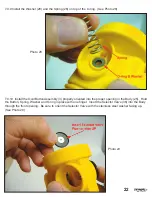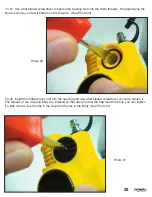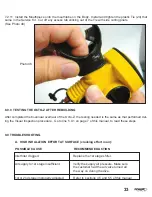
36
10.2 HANDLING TIPS
How your customers treat their regulators will directly influence the unit’s function and durability.
Following are a few tips that you can pass on to your customers to help assure the durability of
their Zeagle Scuba Regulator.
11.0 PRE-DIVE CHECKS:
11.0.1 Check the hoses and hose connections for cuts, abrasions or other signs of damage
before mounting the regulator on the tank valve. Slide the hose protectors back to inspect the
areas of the hose normally covered. Be sure all hose connections are tight. With the Octo-Z,
check that the Bx Connection between the Corrugated Hose and the Octo-Z is tight.
10.1 COMMONLY USED CLEANING SOLUTIONS
SOLUTION
COMMENTS
Preferable. Good for plastic, silicone and
plated metal parts.
Ingredients easily available. Approx. 15 min.
cleaning time. May damage chrome finish.
Never use on plastic parts. Vinegar dissolves
the plastics in most polymers making them
brittle and more prone to breakage.
Simple Green® is a readily available
degreaser. Read the product label for mixing
ratios with water.
The preferred choice. Check with the manu-
facturer for strengths and recommended uses
for their cleaners. Choose soap solutions
over acidic ones.
Hot Soapy water
Vinegar and water (equal part solution)
(weaker solution in Ultrasonic Cleaner)
Simple Green ® and Water
Cleaning solutions recommended by ultra-
sonic cleaner manufacturers
10.0 PARTS CLEANING RECOMMENDATIONS
10.0.1 Regulators that see heavy use, particularly those used in salt water, often require extra
effort to remove dirt and corrosion from the parts of the regulator. Some suggested cleaning
solutions are listed at the end of this section, and there are probably many others being used
successfully. The following are a few general suggestions we can make.
10.0.2 Don’t expect your cleaning solution to do all the work in a matter of seconds. If the
solution cleans extremely rapidly, it is probably too strong and is etching the finish on the parts.
Use a wooden or plastic stick or a soft bristle brush to help get rid of the thickest deposits. Take
special care not to damage orifice sealing areas.
10.0.3 Soft parts absorb ultrasonic energy. Remove all O-rings and seals from metal parts
before cleaning them. If possible, do not clean plastic parts with the metal parts, or at least
understand that every plastic part you put into the ultrasonic cleaner is slowing down the ultra-
sonic cleaning process for the rest of the parts.





































